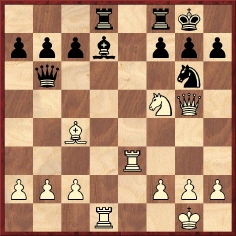
Edward Winter
One way in which an ordinary amateur can become a chess immortal is by being in the right place at the right time. If, for instance, he is on the scene just as a new prodigy emerges, even an inglorious defeat will perpetuate his memory. A case in point is Juan Corzo, for whom the right place and time were Havana 1901, when he lost an historic match to the young Capablanca. Two of Corzo’s defeats are among the most celebrated games in literature, and his name will be remembered as long as chess is played.
But despite this, and to say nothing of the further publicity he gained by being on the sharp end of a Capablanca brilliancy prize game in the Havana, 1913 tournament, Corzo’s immortality clearly has its limits. Hardly anyone nowadays knows anything about him, and it is not easy to find out more. Investigations are hindered by the erratic nature of Cuban periodical literature, which is all fits and starts. Time and again, new chess journals have wobbled along to an early grave, and throughout most of Corzo’s life the country was without any specialized magazine. Chess books appeared at the rate of two or three a decade; Corzo wrote none and none wrote about Corzo.
Juan Corzo y Príncipe was born in Madrid on 24 June 1873 but moved to Cuba when he was in his mid-teens. The first serious event in which he appears to have participated was the championship of the Havana Chess Club in 1896. He came fourth but won the brilliancy prize for his game against Manuel Golmayo:
Juan Corzo – Manuel Golmayo
Havana, 4 October 1896
Two Knights’ Defence
(Notes by Corzo)
1 e4 e5 2 Nf3 Nc6 3 Bc4 Nf6 4 d4 Nxe4 5 dxe5 Nc5 6 O-O Be7 7 Nc3 O-O 8 Nd5 d6 9 Bf4 (‘Janowsky says that 9 Nxe7+ is stronger, because after 9...Nxe7 or 9...Qxe7 White could reply 10 exd6, leaving Black with an isolated pawn and the bishop pair against bishop and knight while also holding the open central files for his rooks.’) 9...dxe5 10 Nxe5 Bd6 11 Nd3 Ne6 12 Bxd6 Qxd6 13 Ne3 Ne7 (‘13...Nf4 would have been better.’) 14 Qh5 Bd7 15 Rad1 Ng6 16 Nf5 Qb6 17 Rfe1 Rad8 18 Re3 Nef4 19 Nxf4 Nxf4 20 Qg5 Ng6

21 Bxf7+ Kxf7 22 Re7+ Nxe7 23 Qxg7+ Ke6 24 Qxe7+ Resigns. (‘Mate cannot be prevented. An elegant finish which earned me the brilliancy prize.’)
Source: Ajedrez en Cuba by C. Palacio (Havana, 1960), pages 265-266. The game was also annotated by Janowsky on pages 233-234 of La Stratégie, 15 August 1897. He described 21 Bxf7+ as a ‘très jolie terminaison’.
Manuel Golmayo’s father was Celso Golmayo y Zúpide, who had been generally accepted as Cuban champion since his 1862 match defeat of Félix Sicre. Celso did not play in the 1897 national championship tournament, but his title stayed in the family because another son, Celsito, was declared champion after a play-off against Andrés Clemente Vázquez. Although Corzo finished only fourth, he was evidently improving rapidly; in the following year’s tournament he won the national title outright. There was no immediate call for him to defend it.
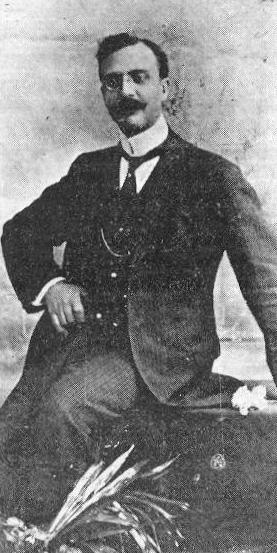
Juan Corzo
(American Chess Bulletin, June 1912, page 136)
In early 1900 Corzo played two matches against Vázquez in Havana, winning the first +4 –0 =0 whereas Vázquez won the second +7 –5 =6. The latter contest was suspended on 19 March (when the score stood at +5 –5 =3) for a visit by Pillsbury. Play between Corzo and Vázquez resumed on 24 March and finished on 30 March.These details, together with the five sample games below, are taken from La Stratégie, which had extensive coverage of the matches (15 March 1900, pages 65-67; 15 April 1900, page 115; 15 May 1900, pages 137-143 and page 148; 15 June 1900, pages 170-178). Since the games were contested less than two years before the Capablanca v Corzo series, it is of interest to witness Corzo’s level of play.
Juan Corzo – Andrés Clemente Vázquez
First game of the first match, Havana, 2 February 1900
Sicilian Defence
1 e4 c5 2 Nf3 Nc6 3 d4 cxd4 4 Nxd4 e6 5 Nc3 a6 6 Be2 Bc5 7 Nb3 Ba7 8 Bf4 Nge7 9 Bd6 O-O 10 h4 b5 11 Qd3 Bb8 12 O-O-O Qb6 13 Nc5 Rd8 14 Qg3 Qxc5 15 Bxc5 Bxg3 16 fxg3 f5 17 g4 b4

18 Nd5 exd5 19 exd5 Re8 20 dxc6 Nxc6 21 Bc4+ Kh8 22 gxf5 Ne5 23 Bd5 Rb8 24 Rhe1 Rb5 25 Bd6 Rxd5 26 Rxd5 Nd3+ 27 Rxd3 Rxe1+ 28 Kd2 Re4 29 Re3 Bb7 30 Rxe4 Bxe4 31 g4 h5 32 gxh5 Bxf5 33 Bxb4 Kg8 34 Bd6 Kf7 35 c4 Ke6 36 Bf4 d6 37 h6 gxh6 38 Bxh6 Bg6 39 Kc3 Kd7 40 Kb4 Kc6 41 Bg7 Bf7 42 Bd4 Bh5 43 b3 Be2 44 Kc3 Kd7 45 Kd2 Bh5 46 a4 Bf7 47 Kc3 Kc6 48 b4 Kb7 49 b5 a5 50 Bf6 Kc7 51 Bg5 Bh5 52 Bf4 Black resigns.
Andrés Clemente Vázquez – Juan Corzo
Second game of the first match, Havana, 3 February 1900
Two Knights’ Defence
1 e4 e5 2 Nf3 Nc6 3 Bc4 Nf6 4 Nc3 Bb4 5 a3 Bxc3 6 dxc3 d6 7 O-O Bg4 8 h3 Bh5 9 Re1 Qd7 10 b4 Ne7 11 Qd3 h6 12 Nh2 Bg6 13 f3 d5 14 Bb3 Rd8 15 Qe3 dxe4 16 Qxa7 b6 17 Qa6 O-O 18 Qe2 Qc6 19 c4 Qa8 20 Bb2 Nc6 21 Qf2 Nd4 22 f4 Nxb3 23 cxb3
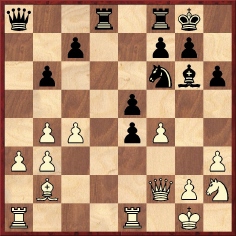
23...e3 24 Rxe3 exf4 25 Re2 Nh5 26 Nf1 Rd3 27 Be5 f3 28 Re3 fxg2 29 Qxg2 Qd8 30 Rae1

30...Re8 31 Bxc7 Rexe3 32 Bxd8 Rxe1 33 Bh4 Ra1 34 Qf2 Rdd1 35 Qg2 Bd3 36 Qa8+ Kh7 37 Kf2 Ra2+ 38 Kf3 Rxf1+ 39 Ke3 Rd1 40 Qa7 Bg6 41 White resigns.
Juan Corzo – Andrés Clemente Vázquez
Third game of the first match, Havana, 4 February 1900
Vienna Gambit
1 e4 e5 2 Nc3 Nc6 3 f4 d6 4 Nf3 exf4 5 d4 g5 6 h4 g4 7 Ng5 h6 8 Nxf7 Kxf7 9 Bxf4 Bg7 10 Be3 Nf6 11 h5 Re8 12 Bc4+ Kf8 13 O-O Na5 14 Bd3 Kg8 15 b4 Nc6 16 Bc4+ Kh7 17 Bf7 Rf8 18 Bg6+ Kh8 19 Qd2 Qe7 20 Bxh6 Bd7 21 Bg5 Kg8 22 Nd5 Qd8 23 Bxf6 Rxf6 24 Nxf6+ Bxf6 25 e5 Bg5
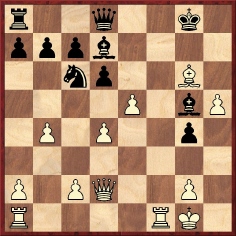
26 Rf8+ Qxf8 27 Qxg5 Nxd4 28 Bf5+ Qg7 29 Qxg7+ Kxg7 30 Bxd7 dxe5 31 Bxg4 c6 32 c3 Nb5 33 Rc1 Rd8 34 a4 Nc7 35 c4 Rd4 36 Bc8 b6 37 Bb7 c5 38 bxc5 bxc5 39 Bc8 Kh6 40 g4 Ne8 41 Rf1 Nd6 42 Rf6+ Kh7 43 Be6 e4 44 Kf2 Rd2+ 45 Ke3 Rd3+ 46 Ke2 Rg3 47 Bg8+ Kxg8 48 Rxd6 Rc3 49 Rd8+ Kf7 50 h6 Kg6 51 Rd6+ Kg5 52 Rd5+ Kxg4 53 Rxc5 Kf4 54 Rh5 Re3+ 55 Kd2 Rd3+ 56 Kc2 Rd8 57 h7 Rh8 58 Kd2 Kg4 59 Rh1 Kf4 60 Rf1+ Ke5 61 Rf7 Rd8+ 62 Ke2 Rb8 63 Rb7 Rf8 64 Rg7 Rh8 65 Ke3 a5 66 Rg5+ Kd6 67 Rh5 Kc6 68 Kxe4 Kb6 69 Kf5 Kc5 70 Kg6+ Kb4 71 Kg7 Rxh7+ 72 Kxh7 Kxa4 73 Rb5 Black resigns.
Andrés Clemente Vázquez – Juan Corzo
Fourth game of the first match, Havana, 7 February 1900
King’s Gambit Accepted
1 e4 e5 2 f4 exf4 3 Nf3 g5 4 Bc4 Bg7 5 d4 d6 6 h4 h6 7 hxg5 hxg5 8 Rxh8 Bxh8 9 Qd3 Nh6 10 g3 Nc6 11 c3 Qe7 12 Bb5 Bd7 13 gxf4 g4 14 Ng1 d5 15 e5 Qh4+ 16 Kd1 Qh1 17 Qf1 O-O-O 18 Bxc6 bxc6 19 Nd2 Bf5 20 Ne2 Qh4 21 Qg2 Bd3 22 Nf1 Nf5 23 Be3 g3 24 Kd2 Be4 25 Qg1
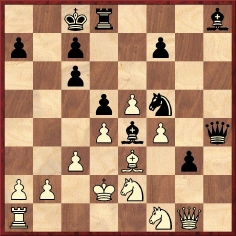
25...g2 26 Nh2 Qh3 27 Bf2 Bg7 28 Nf1 gxf1(Q) 29 Qxf1 Qd3+ 30 Ke1 Rh8 31 Ng1 Qxf1+ 32 Kxf1 Rh2 33 Rd1 Bh6 34 Ke1 Bxf4 35 Ne2 Rh1+ 36 Ng1 Ne3 37 White resigns.
Juan Corzo – Andrés Clemente Vázquez
Third game of the second match, Havana, 18 February 1900
Petroff Defence
1 e4 e5 2 Nf3 Nf6 3 Nxe5 d6 4 Nf3 Nxe4 5 d4 d5 6 Bd3 Nc6 7 O-O Be7 8 Re1 Bg4 9 Bxe4 dxe4 10 Rxe4 f5 11 Re1 Bxf3 12 Qxf3 Nxd4 13 Qxb7 Kf8 14 Na3 Bxa3 15 bxa3 Nxc2
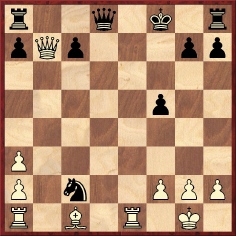
16 Bg5 Qc8 17 Be7+ Kf7 18 Qd5+ Kg6 Black resigns
After winning two informal games against Capablanca in September/October 1901, Corzo faced the prodigy in the now famous match, which lasted from 17 November to 18 December 1901 and ended in victory for Capablanca by +4 –3 =6. It used to be feared that only the two games Capablanca published in My Chess Career had survived, but the remaining scores have since trickled into circulation, largely thanks to the research of Miguel Alemán, E.W. Axe, James Gilchrist and Paul Leith. A number appeared in the BCM in 1960 and two subsequent books published the full set: Los niños prodigio del ajedrez by Pablo Morán (Barcelona, 1973) and The Unknown Capablanca by David Hooper and Dale Brandreth (London, 1975). The latter work gave the clock times, showing that Capablanca played at an average speed of 90 moves an hour.
The exact status of the match is debatable. Capablanca wrote in My Chess Career, ‘the victory made me, morally at least, the champion of Cuba’, but in the Buenos Aires newspaper La Crítica of 19 September 1927 he remarked after his first match game against Alekhine in the world championship: ‘Since my first match, with Corzo for the Cuban Championship, when I was 12 years of age, this is the first time in a match that my opponent has taken the lead, which does at least have the merit of a novelty.’ Corzo’s view on the 1901 match was that they were ‘offhand games’ (El Fígaro, 25 April 1909, page 219).
Finally, it is worth noting that even today the year of the match is often wrongly given as 1900, whereas the correct date, 1901, is confirmed by local newspaper reports. The error may be traced back to the games index of My Chess Career.
In 1902 Corzo retained/regained his national title in a double-round championship tournament, finishing 2½ points ahead of his brother Enrique, and four ahead of Capablanca, who came only fourth. Corzo won both of his individual games against the prodigy, but the scores seem to have been lost.
It is almost certain that another celebrated Corzo v Capablanca brilliancy (game 2a in Reinfeld’s The Immortal Games of Capablanca) did not involve Juan Corzo at all, despite that attribution on page 136 of The Unknown Capablanca. Although the Cuban newspaper Diario de la Marina of 5 February 1902 (evening edition, page 4) claimed that White was Juan Corzo, Juan himself said in the Mexican magazine Ajedrez of February 1938 (page 129) that Capablanca’s opponent had been his brother, Enrique (who had died in the early 1930s).
Ajedrez en Cuba, a scarce book by Carlos Palacio published in Havana in 1960, lists further match results of Juan Corzo: v Ramón Iglesias (1897) +5 –0 =1; v Rafael Blanco (1911) +5 –0 =0. The American Chess Bulletin of May 1912 (page 106) mentions another match against Iglesias, played in 1901, Corzo winning +7 –5 =2. This source also says that Corzo had won casual games from Dr Lasker and Taubenhaus. A number of games between Lasker and Corzo were given in The Collected Games of Emanuel Lasker by K. Whyld, published in 1998.
The following correspondence game against the ‘Club Capablanca’ of Placetas, taken from Crónica de Ajedrez of August 1911 (pages 82-83), is a good example of Corzo’s aggressive style, although here it is unsuccessful. The annotations (written before 5...d5 was discovered – see page 158 of Kings, Commoners and Knaves) are by Corzo:
Club Capablanca – Juan Corzo
Correspondence game
Danish Gambit
1 e4 e5 2 d4 exd4 3 c3 dxc3 4 Bc4 cxb2 (‘The theorists consider that it is dangerous to accept the third pawn. Nonetheless in practice the position is defendable and Mieses, that great advocate of the Danish Gambit, has suffered reverses, such as the game he lost to Maróczy in the Paris tournament of 1900, which seem to demonstrate quite the opposite. In other words, the danger involved in playing this opening is greater for White than for Black.’) 5 Bxb2 d6 6 Nf3 Qe7 7 O-O Be6 8 Qb3 Nd7 9 Bxe6 Qxe6 (‘A fundamental error. 9...fxe6, followed by 10...Nc5 would have given Black a solid position.) 10 Qxb7 Rb8 (‘When I played this move I saw the attack with which I should be confronted, but I preferred a rapid death to the kind that would have awaited me if I had played 10...Nb6 or some similar move leaving me with the same number of pawns and an inferior position.’) 11 Qxc7 Rxb2 12 Qc8+ Ke7 13 Nd4 Qxe4 14 Nc6+ Kf6 15 Qxd7 (‘15 Nc3, and if 15...Qf5 then 16 Rad1, would seem very strong.’) 15...Rc2 16 Nxa7 d5
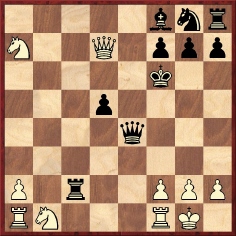
17 Nc3 (‘An unexpected sacrifice which proves sound.’) 17...Rxc3 18 Nb5 Rc2 (‘The position is interesting. Another possible defensive move is 18...Rc4, but the entry of the White rook and the bad position of the Black king would make the second player’s situation almost desperate.’) 19 Rae1 Re2 20 Qc6+ Qe6 21 Qc3+ Kg6 22 Qd3+ Re4 23 f3 Bc5+ 24 Kh1 Nf6 25 fxe4 Nxe4 (‘The decisive error. 25...dxe4 would have left drawing chances.’) 26 Nc7 (‘Well played. If 26 Nc3, Black could have drawn by perpetual check: 26...Re8 27 Nxd5 Qxd5 28 Qxd5 Nf2+ 29 Kg1 Nh3+.’) 26...Qe5 27 Nxd5 f5 28 Nf4+ Kg5 29 Rxe4 (‘Brilliant and decisive. Black is irretrievably lost irrespective of whether he accepts the sacrifice.’) Black resigned.
As regards the annotation by Corzo at move four, the Mieses v Maróczy game at Paris, 1900 was not a Danish Gambit. Corzo was probably thinking of Mieses’ loss in 24 moves at Monte Carlo, 1903.
His only full-scale international tournament was Havana, 1913, where he brought up the rear but produced many of the liveliest games.
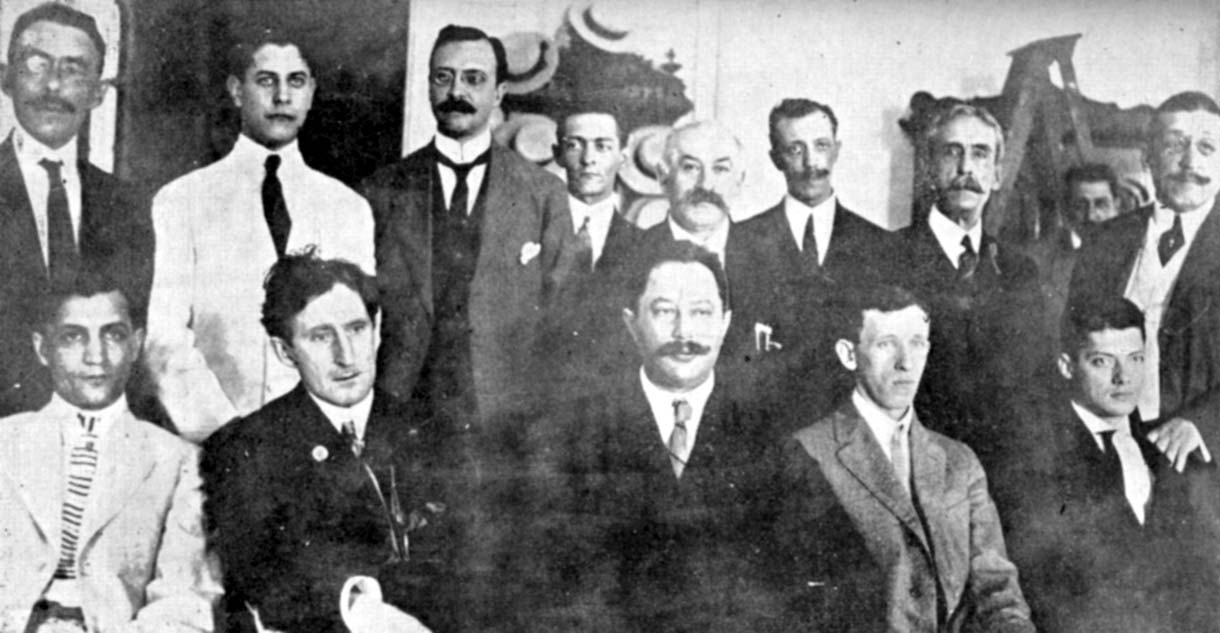
Havana, 1913
Standing from left to right: D. Janowsky, J.R. Capablanca, J.
Corzo, S. Capablanca, H. Cassel, E. Corzo, A Ponce, L. Paredes
Seated: C. Jaffe, F.J. Marshall, O. Chajes, A. Kupchik, R.
Blanco.
Four years later Juan Corzo came second in a small triangular tournament in the Cuban capital, half a point behind C.S. Howell and half a point ahead of Blanco.
Corzo was a prolific journalist who wrote columns in a variety of publications over a 30-year period. His weekly column in the Cuban magazine E1 Fígaro was particularly rich, frequently containing four or five games, two problems and general chess news, all spread out over a full page. He also played a key role in Capablanca-Magazine, which enjoyed a relatively long run (1912 to 1914). Corzo was described as the Administrador.
A good illustration of his play during this period was published in Capablanca-Magazine of 31 December 1913 (pages 235-236):
Juan Corzo – J.A. Buch
Occasion?
Scotch Game
1 e4 e5 2 Nf3 Nc6 3 d4 exd4 4 Bc4 Be7 5 Nxd4 Ne5 6 Bb3 d6 7 f4 Ng6 8 O-O Nf6 9 Nc3 Ng4 10 Nf5 h5 11 Nxg7+ Kf8 12 Qd5 Nh6 13 f5 Ne5 14 Bxh6 Rxh6 15 Ne6+ Bxe6 16 fxe6 c6 17 Qd2 Bg5 18 Qe2 f6 19 Rad1 Qc7 20 Rf5 Ke7 21 Qf2 Rg6 22 Rxe5 Rag8
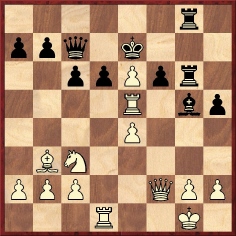
23 Red5 Bh4 24 Qxh4 Qb6+ 25 Rld4 Rxg2+ 26 Kf1 Rd2 27 e5 Rg6 28 exd6+ Kd8 29 e7+ Kd7 30 e8(Q)+ Kxe8 31 Qe4+ Kf7 32 Qe7+ Kg8 33 Rg5+ Resigns.
An odds game against María Teresa Mora Iturralde, played in late 1915 or early 1916 was given in C.N. 1178. (See also page 56 of Chess Explorations.)
Corzo sometimes took a board in Capablanca’s simultaneous exhibitions in Havana, and one of the few available scores is the following:
José Raúl Capablanca – Juan Corzo
Havana, 28 March 1931
Queen’s Gambit Declined
1 d4 d5 2 c4 e6 3 Nf3 Nd7 4 Nc3 Ngf6 5 Bg5 Bb4 6 Qb3 c5 7 cxd5 exd5 8 a3 Bxc3+ 9 Qxc3 c4 10 b3 Ne4 11 Bxd8 Nxc3 12 Ba5 Ne4 13 bxc4 dxc4 14 Nd2 Nxd2 15 Kxd2 b6 16 Bc3 Ba6 17 e4 O-O-O 18 Ke3 Rhe8 19 f3 f5 20 e5 Nf6 21 g3 Nd5+ 22 Kd2 Kd7 23 Bg2 Ke6 24 f4 Bb7 25 Rhg1 b5 26 Rab1 a6 27 a4 Bc6 28 axb5 axb5 29 Bxd5+ Kxd5 30 g4 fxg4 31 Rxg4 g6 32 Rh4 h5 33 Rh3 Ra8 34 Rg3 Re6 35 Rb2 Ke4 36 Re3+ Kxf4 37 Rb1 Ra2+ 38 Bb2 b4 39 Rf1+ Kg5 40 White resigns.
Source: Diario de la Marina, 30 March 1931, page 12.
Not long afterwards, Corzo embarked upon a new literary venture. This paragraph appeared on page 463 of the November 1933 BCM:
‘In spite of political troubles, Juan Corzo, ex-champion of the Havana Chess Club, has succeeded in bringing out the first (September) number of a new monthly, Jaque Mate, at the price of $1 a year. Most of the space in this opening issue is given to the games of the historic match Corzo-Capablanca at the end of 1901, begun just before Capablanca’s 13th birthday. There is also an article on “World Champions from Ruy López to Alekhine”.’
Despite considerable efforts, it has proved impossible to trace this magazine, or even to find a reference to it in any Cuban source. (It is unconnected with the Jaque Mate published in Havana in the 1960s and 1970s.)
The name of Corzo was seldom seen in print during the 1930s, although he contributed a brief analytical article on the game between Sir George Thomas and Vera Menchik, Hastings, 1934-35 on pages 364-365 of El Ajedrez Español, August 1935. See also pages 485-490 of the December 1935 issue.

Juan Corzo
Corzo is such an obscure figure that it is appropriate that there should even have been confusion over when he died. In reference books the date was regularly given as 27 September 1938 until it was pointed out in C.N. 1085 that the October/November 1944 issue of Capablanca Magazine and issues 7, 8 and 9 of Jaque Mate 1964 contained photographs of Corzo taken on 13 April 1940 and 21 March 1941.
It turned out that Corzo died, in Havana, on 27 September 1941. Capablanca survived him by just five months.
Afterword: This original version of the above article was published on pages 76-78 of the 8/1988 New in Chess.
This was the position after White’s 26th move in the game J. Corzo v C. Jaffe, Havana, 1913:
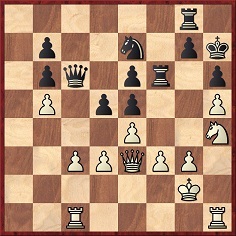
Jaffe now played 26...Qd6, and Capablanca gave the following note in his book on the event, Torneo internacional de ajedrez:
‘26...Qxb5 was without any doubt the best move, and if then 27 Rb1, see the following variation: 27 Rb1 Qa5 28 d4 (not 28 Rxb6 d4 and if 28 Qxb6 Qxc3) 28...exd4 29 cxd4 Qa2+ 30 Kh3 g5! 31 hxg6+ Nxg6 32 e5 Nxh4! 33 exf6 Nf5 34 Qf4 Rxg3+ 35 Qxg3 Nxg3 36 Kxg3 Qd2 or 36...Kg6 and Black will at least draw.’
But why not simply 33...Qg2+ 34 Kxh4 Qxg3+ 35 Kh5 Rg5+ 36 Qxg5 Qxg5 mate?
These notes are to be found on page 57 of the Cuban original of the tournament book by Capablanca (page 35 of the English translation). The translator’s only excuse would be that nobody would expect Capablanca to give a drawing variation where a mate in four is on ...
(227)
Eduardo Bauzá Mercére (New York, NY, USA) forwards a game (Havana, 1936) between Juan Corzo and José Antonio Gelabert which the former published on page 129 of the 8/1937 issue of the Argentinian magazine Castles:
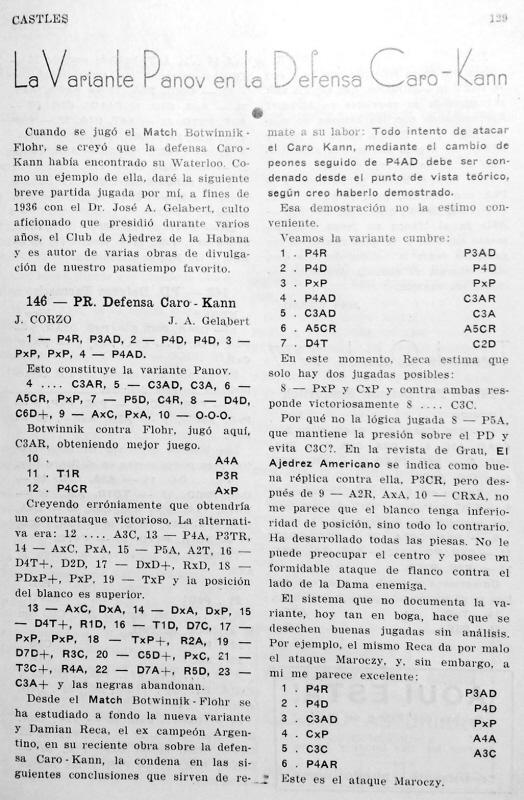
1 e4 c6 2 d4 d5 3 exd5 cxd5 4 c4 Nf6 5 Nc3 Nc6 6 Bg5 dxc4 7 d5 Ne5 8 Qd4 Nd3+ 9 Bxd3 cxd3 10 O-O-O Bf5 11 Re1 e6 12 g4 Bxg4 13 Bxf6 Qxf6 14 Qxg4 Qxf2 15 Qa4+ Kd8 16 Rd1 Qg2
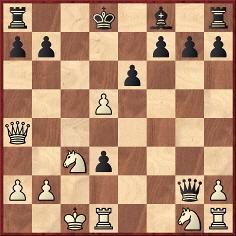
17 dxe6 fxe6 18 Rxd3+ Kc7 19 Qd7+ Kb6 20 Nd5+ exd5 21 Rb3+ Kc5 22 Qc7+ Kd4 23 Nf3+ Resigns.
As shown in our article on David Hooper, C.N. 3227 mentioned a cutting which he sent us for safe keeping on 10 May 1990 regarding a set of games between Capablanca and Delmar. Hooper commented:
‘This is the only written reference I found to a match against Delmar on 27(?) September 1908. It will almost certainly be fromDiario de la Marina(Havana) ... As I understand this match, Capablanca, offering pawn and move, undertook to win every game. I believe he won the match, probably picking up a good stake – he desperately needed money at the time.’
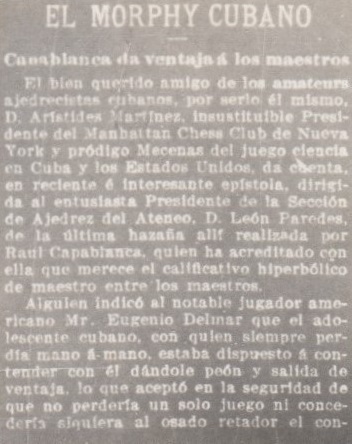
Now, Christian Sánchez (Rosario, Argentina) has forwarded us the remainder of the newspaper item (a report by Juan Corzo in Diario de la Marina, 27 September 1908), together with a full transcription:
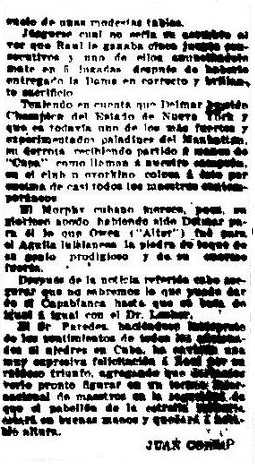
‘El Morphy cubano
Capablanca da ventaja a los maestros
El bien querido amigo de los amateurs ajedrecistas cubanos, por serlo él mismo, D. Arístides Martínez, insustituible Presidente del Manhattan Chess Club de Nueva York y pródigo Mecenas del juego ciencia en Cuba y los Estados Unidos, da cuenta, en reciente e interesante epístola, dirigida al entusiasta Presidente de la Sección de Ajedrez del Ateneo, D. León Paredes, de la última hazaña allí realizada por Raúl Capablanca, quien ha acreditado con ella que merece el calificativo hiperbólico de maestro entre los maestros.
Alguien indicó al notable jugador americano Mr Eugenio Delmar que el adolescente cubano, con quien siempre perdía mano a mano, estaba dispuesto a contender con él dándole peón y salida de ventaja, lo que aceptó en la seguridad de que no perdería un solo juego ni concedería al osado retador el consuelo de unas modestas tablas.
Júzguese cual no sería su asombro al ver que Raúl le ganaba cinco juegos consecutivos y uno de ellos anunciándole mate en 5 jugadas después de haberle entregado la Dama en correcto y brillante sacrificio.
Teniendo en cuenta que Delmar ha sido Champion del Estado de Nueva York y que es todavía uno de los más fuertes y experimentados paladines del Manhattan, su derrota recibiendo partido a manos de “Capa”, como llaman a nuestro campeón en el club neoyorkino, coloca a éste por encima de casi todos los maestros contemporáneos.
El Morphy cubano merece, pues, su glorioso apodo, habiendo sido Delmar para él lo que Owen (“Alter”) fue para el Aguila luisianesa, la piedra de toque de su genio prodigioso y de su enorme fuerza.
Después de la noticia referida cabe asegurar que no sabremos lo que puede dar de sí Capablanca hasta que se bata de igual a igual con el Dr. Lasker.
El Sr. Paredes, haciéndose intérprete de los sentimientos de todos los aficionados al ajedrez en Cuba, ha enviado una muy expresiva felicitación a Raúl por su valioso triunfo, agregando que deseamos verlo pronto figurar en un torneo internacional de maestros en la seguridad de que el pabellón de la estrella solitaria estará en buenas manos y quedará a notable altura.
Juan Corzo.’
(9315)
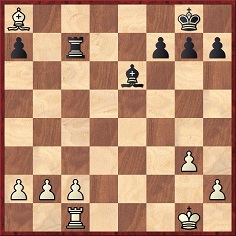
This position is from a game between Capablanca (Black) and Juan Corzo in Havana on 21 July 1909. It was published on page 197 of the American Chess Bulletin, September 1909 and was included on pages 37-38 of The Unknown Capablanca by David Hooper and Dale Brandreth (London, 1975). Page 199 gave as the source the Cuban newspaper Diario de la Marina, 22 July 1909.
From page 38 of The Unknown Capablanca:
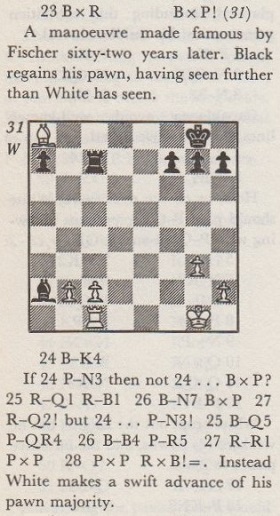
The Fischer game (played almost exactly 63 years after Corzo v Capablanca) did not need to be identified.
(9805)
For the remainder of the above C.N. item and further discussion of Fischer’s move, see Section 6 of our feature article on the 1972 Spassky v Fischer match.
From pages 6 and 17 of the 9 October 1927 issue of Carteles magazine:
Two further pieces by Corzo in the same Cuban publication:
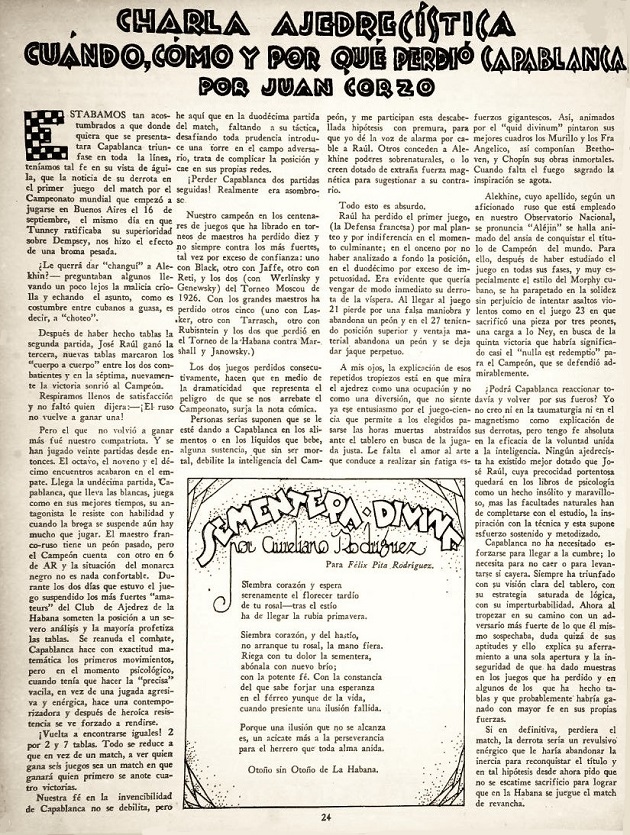
Carteles, 20 November 1927, page 24
(11271)
Yandy Rojas Barrios (Cárdenas, Cuba) writes:
‘In their match in Havana in 1901, Capablanca won games 4, 8, 9 and 11, and Corzo won games 1, 2 and 13. The result is customarily given as +4 –3 =6. Although there has been much debate about the status of the final 13th game, little has been said about game 12.
In the chapter on the match in My Chess Career (London, 1920) Capablanca wrote:
Capablanca’s fourth victory was in game 11, before which the match score was +3 –2 =5 in his favour. Even so, he also stated that his fourth win was the final game of the contest:
On pages 36 and 37 of Capablanca Biografía (Havana, 1990), Jorge Daubar referred to the 12th game as the last:
Daubar had also produced the games collection Así jugaba Capablanca (Havana, 1988). From page 11:
The ‘12.12.’ indicated that, according to Daubar, that draw with the Ruy López was the last of the match. On the same page the Dutch Defence game, won by Corzo, was numbered not 13 but zero (‘0-0’):
The following page explained that the Dutch Defence game was not included in the total match score (which Daubar therefore gave as +4 –2 =6):
On page 84 of volume one of Capablanca, leyenda y realidad (Havana, 1978) Miguel A. Sánchez wrote that 5½ points were required to win the match and that, therefore, a draw in the 12th game was enough for Capablanca:
This does not make sense because after 11 games Capablanca already had 6½ points.
In José Raúl Capablanca. A Chess Biography (Jefferson, 2015) Sánchez asserted on page 84 that by drawing the 12th game Capablanca won the match:
There was this endnote on page 506:
As shown below, page 4 of Diario de la Marina of 16 November 1901 did indeed state that the winner of the match would be the player who made the better score from seven games, draws not counting:
David Hooper and Dale Brandreth wrote, correctly, on page 116 of The Unknown Capablanca (London, 1975):
However, page 80 of a Spanish version of Miguel A. Sánchez’s McFarland book, entitled Capablanca, leyenda y realidad (Havana, 2017 – although it did not appear until 2019), had the following about game 12:
The corresponding endnote 39 on page 96 affirms that in the Havana Chess Club it was customary to play out all the games of a match even if the final overall result of the contest would not be affected:
Although that clarification was provided to explain why game 13 was played, it could also have been applied to game 12.
In short, it seems to me that contrary to what Daubar and Sánchez have written, the final score must either include both games 12 and 13 or exclude both. It is illogical to include only game 12.’
(11311)
Yandy Rojas Barrios has provided an article by Juan Corzo y Príncipe, written after Emanuel Lasker announced his resignation as world champion, on pages 47 and 76 of Social, July 1920:
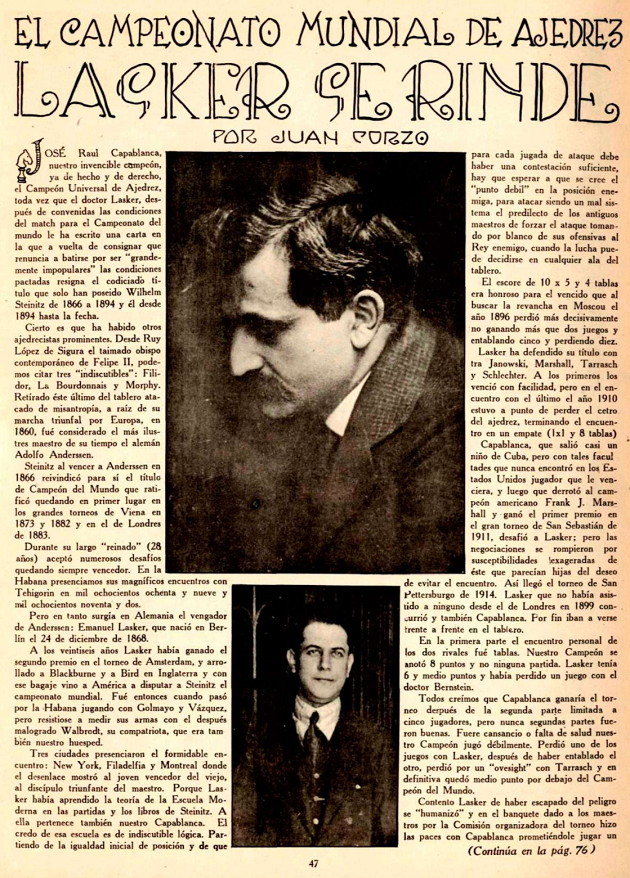
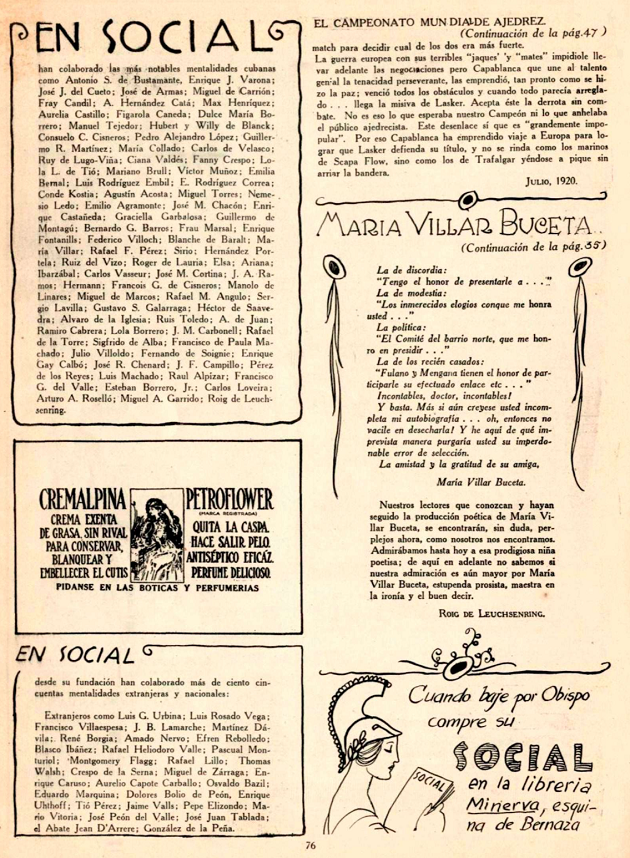
From opposite page 158 of Homenaje a José Raúl Capablanca (Havana, 1943):
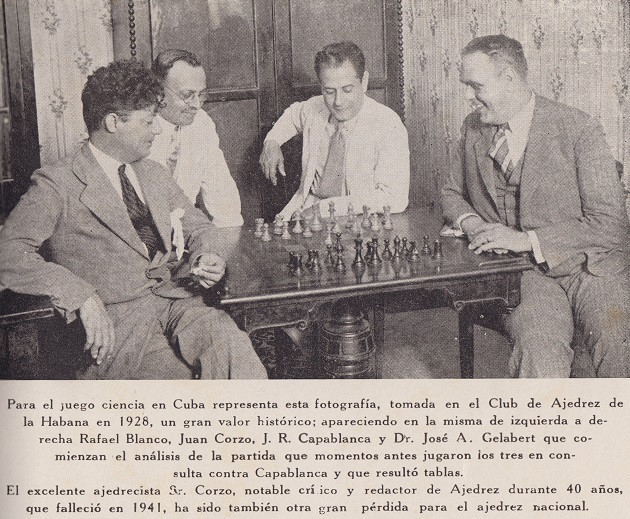
Another version, from our archives:
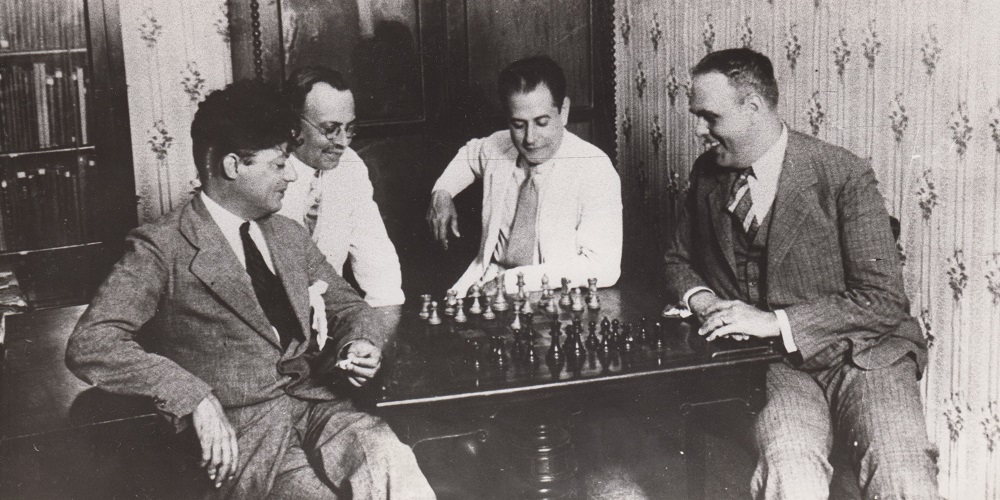
A group photograph (Capablanca v Kostić match, Havana, 1919) opposite page 80 of Glorias del Tablero “Capablanca” by J.A. Gelabert (Havana, 1923):
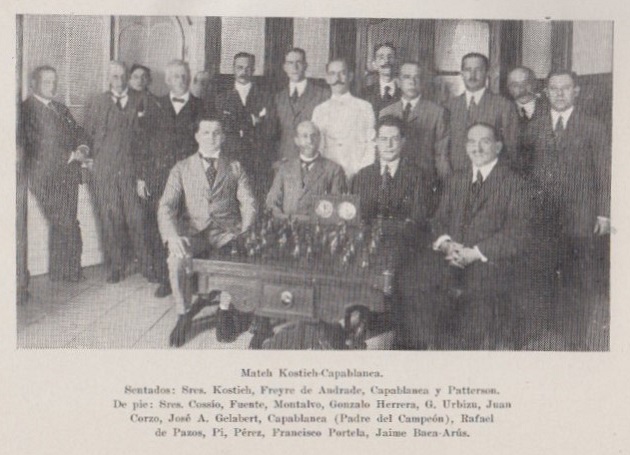
Three articles by Juan Corzo y Príncipe about the 1927 world championship match have been given from Carteles: 9 October 1927, page 17 (C.N. 11260); 20 November 1927, page 24 (C.N. 11271); 18 December 1927, page 25 (C.N. 11271).
Now, Yandy Rojas Barrios has submitted a fourth one, on pages 24 and 27 of the Cuban magazine’s 23 October 1927 edition:
Our Cuban correspondent has also provided 16 articles by Corzo which Carteles published between 28 November 1937 and 4 December 1938.
(11829)
In the 16 Carteles articles referred to above Mr Rojas has marked in red the most significant passages:

28 November 1937, page 12
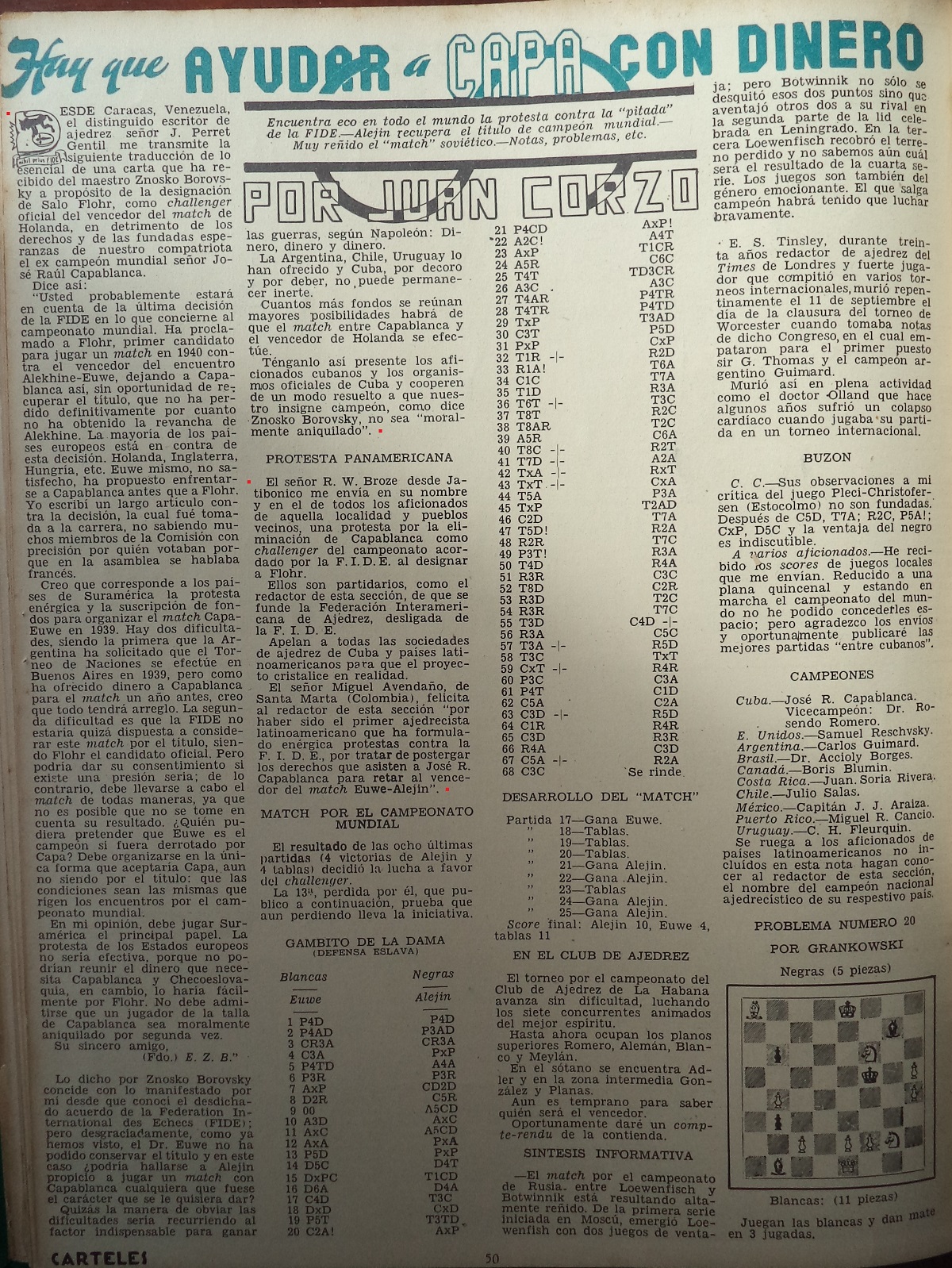
19 December 1937, page 50

2 January 1938, page 64

30 January 1938, page 13

13 February 1938, page13

27 February 1938, page 13

13 March 1938, page 13

27 March 1938, page 13
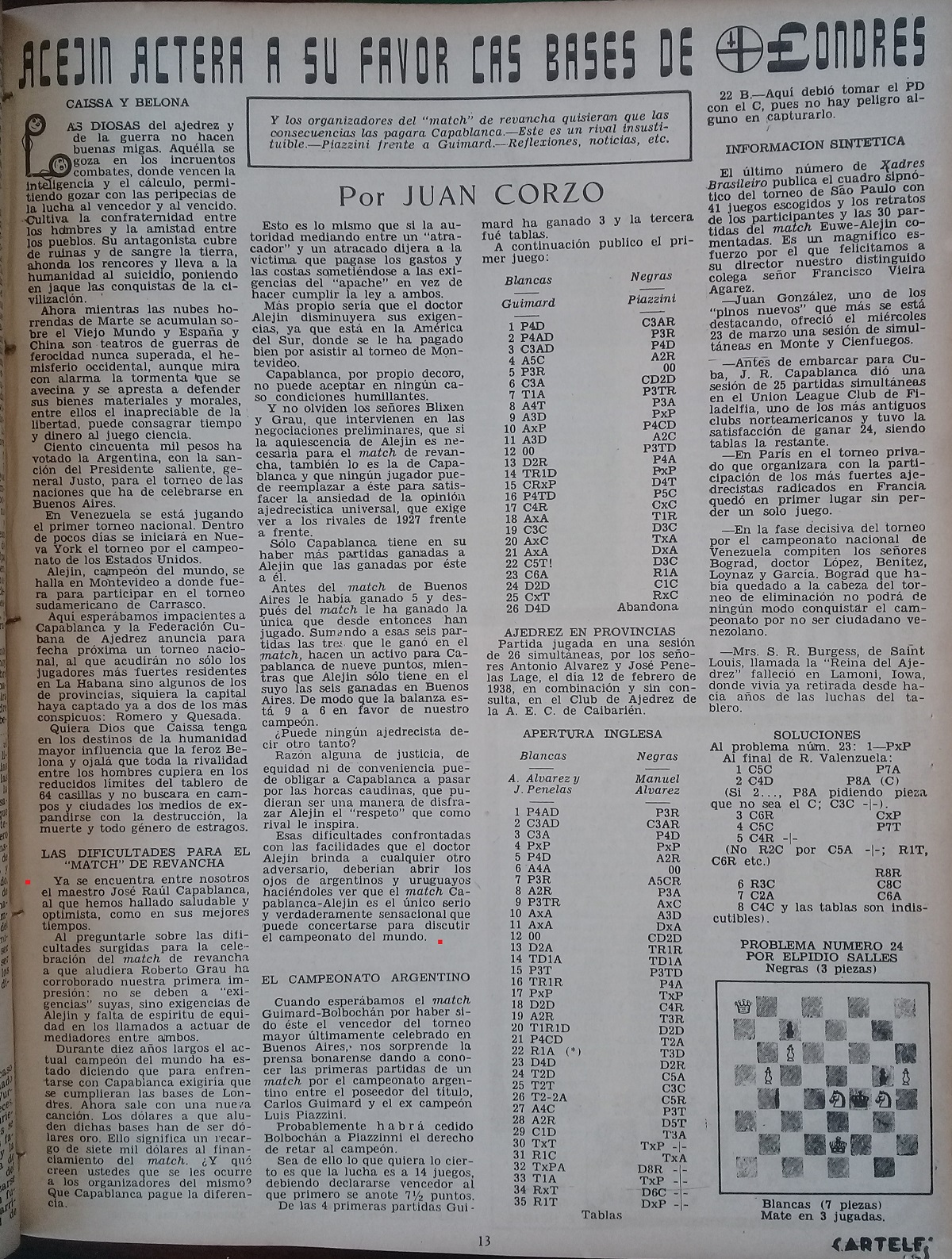
10 April 1938, page 13
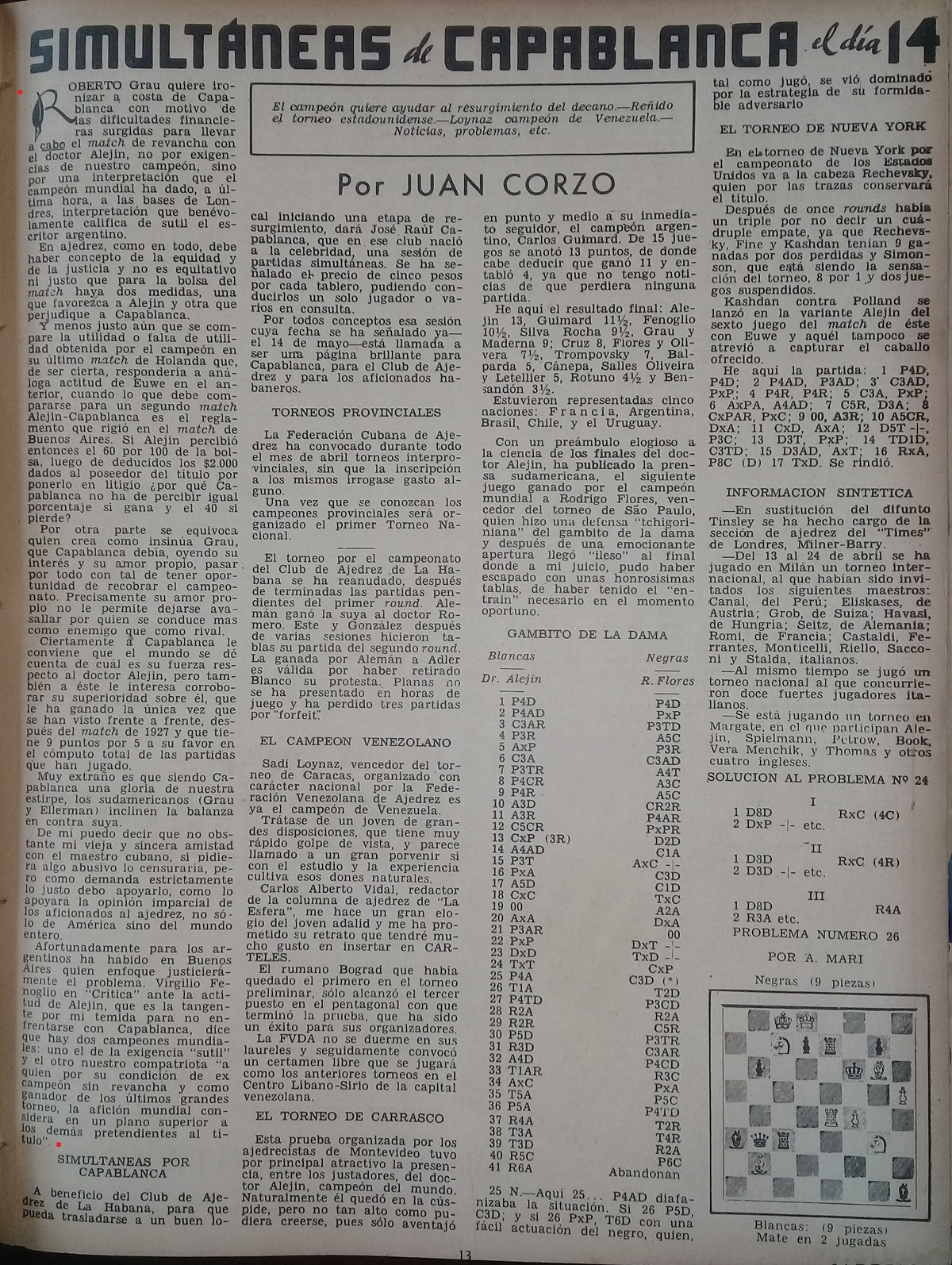
8 May 1938, page 13
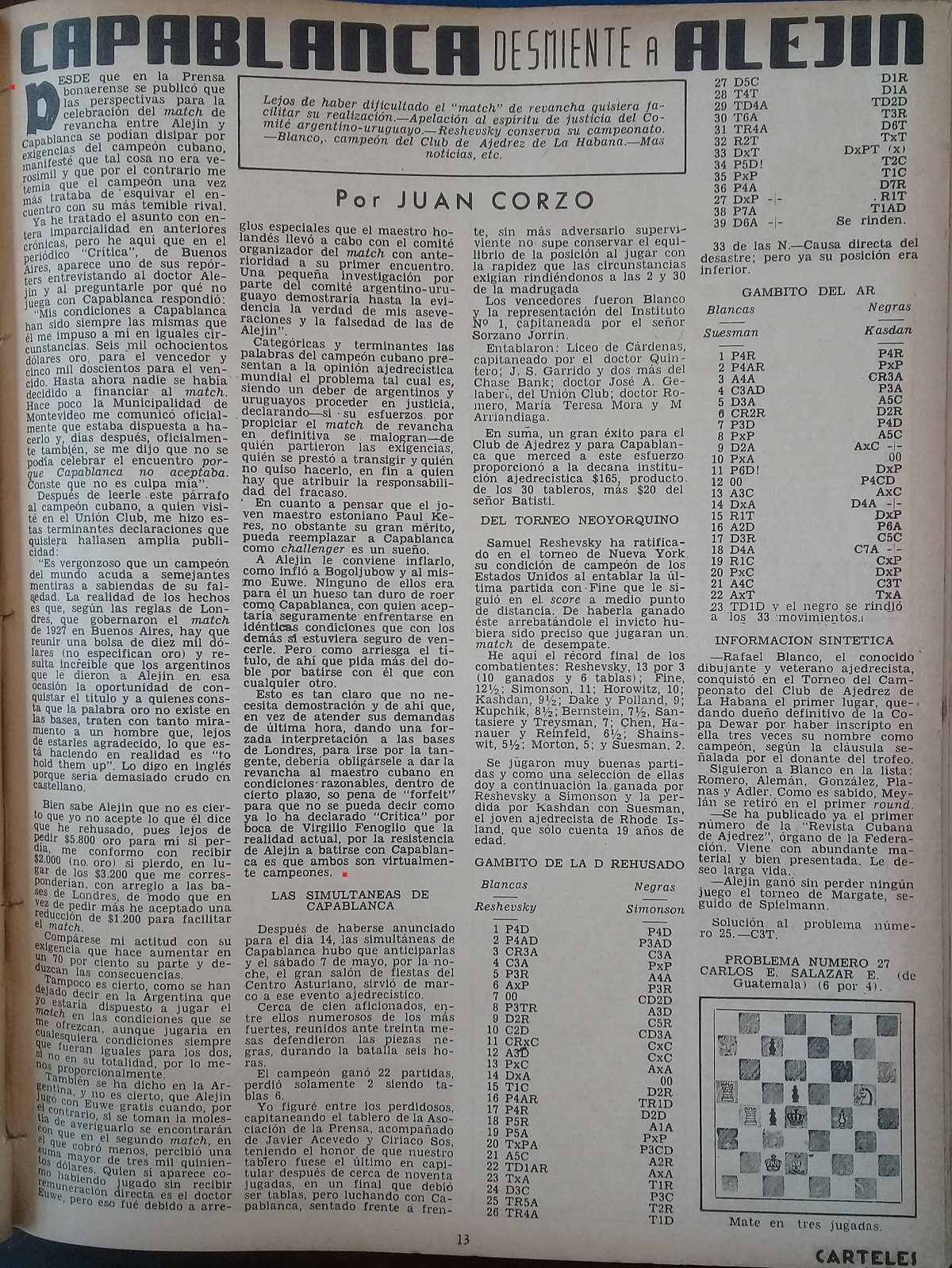
22 May 1938, page 13
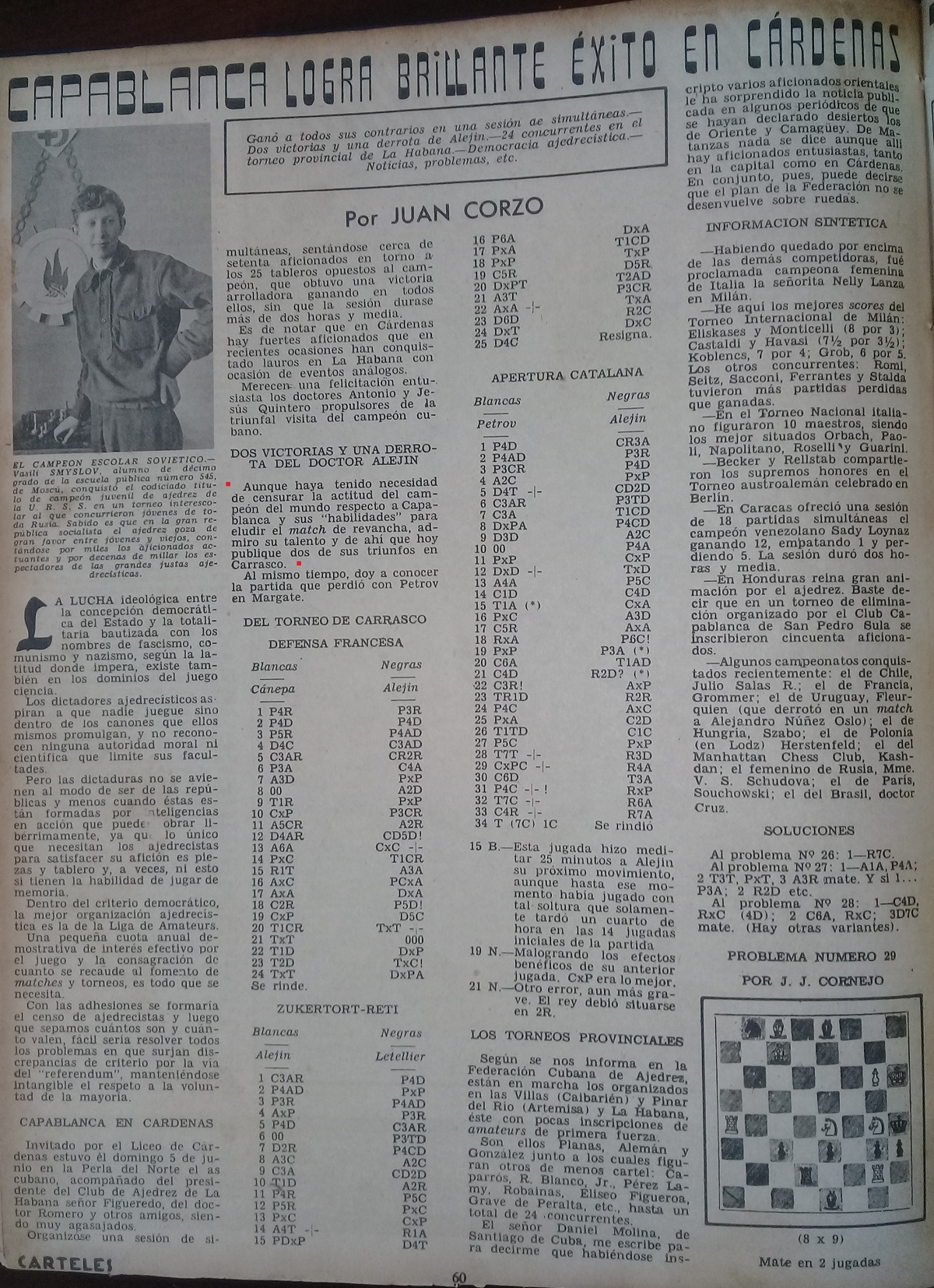
19 June 1938, page 60
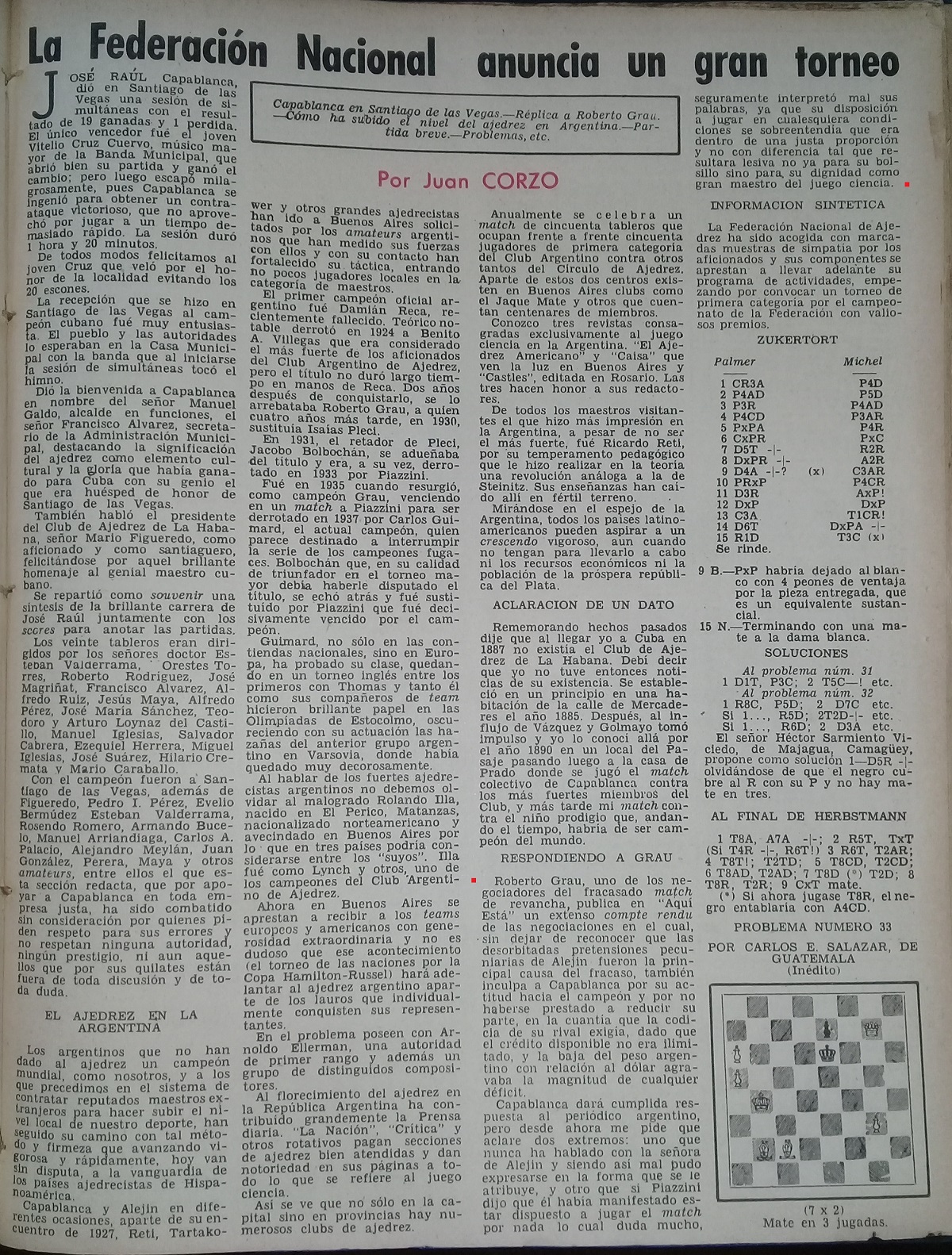
28 August 1938, page 11
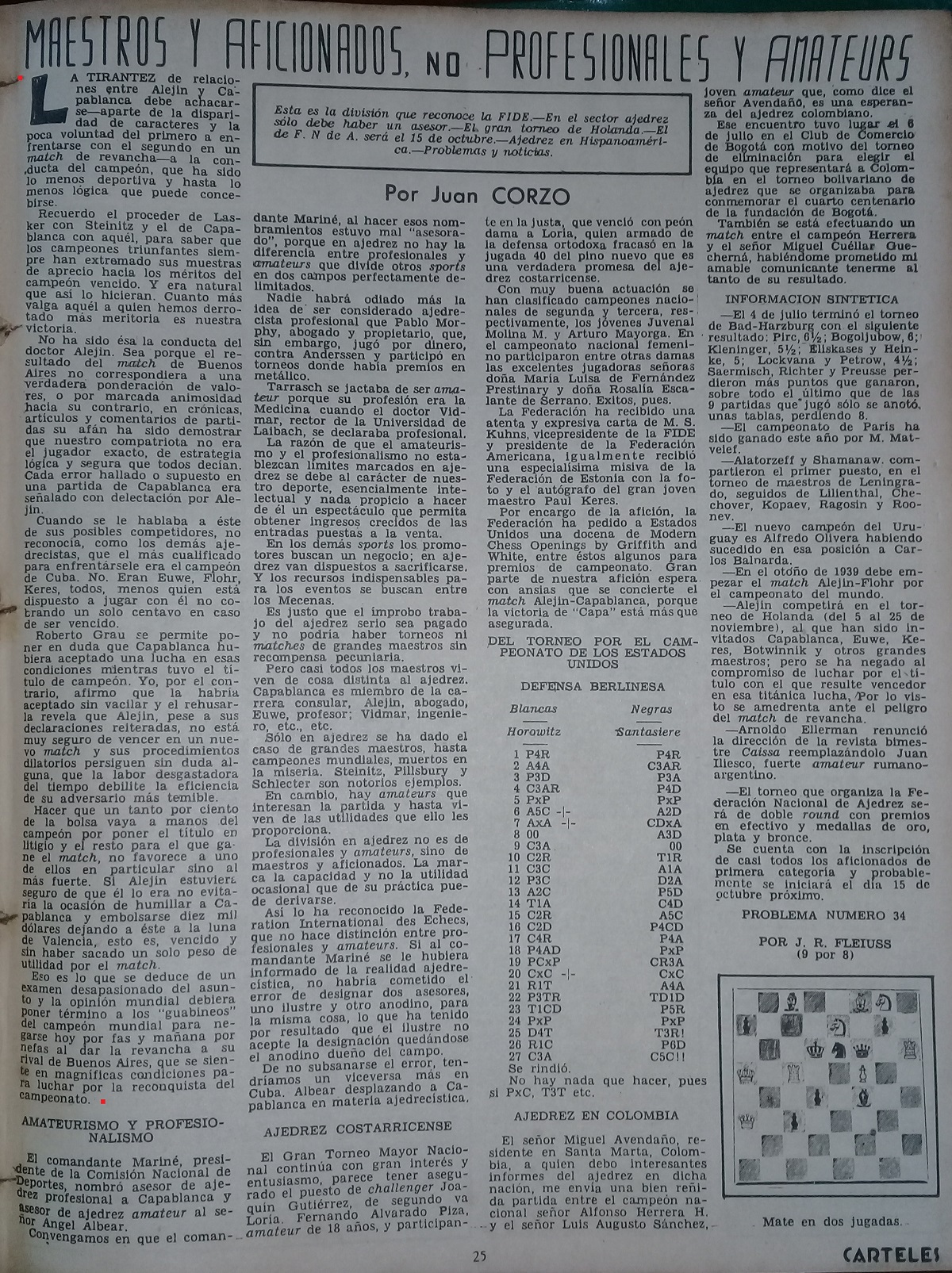
11 September 1938, page 25
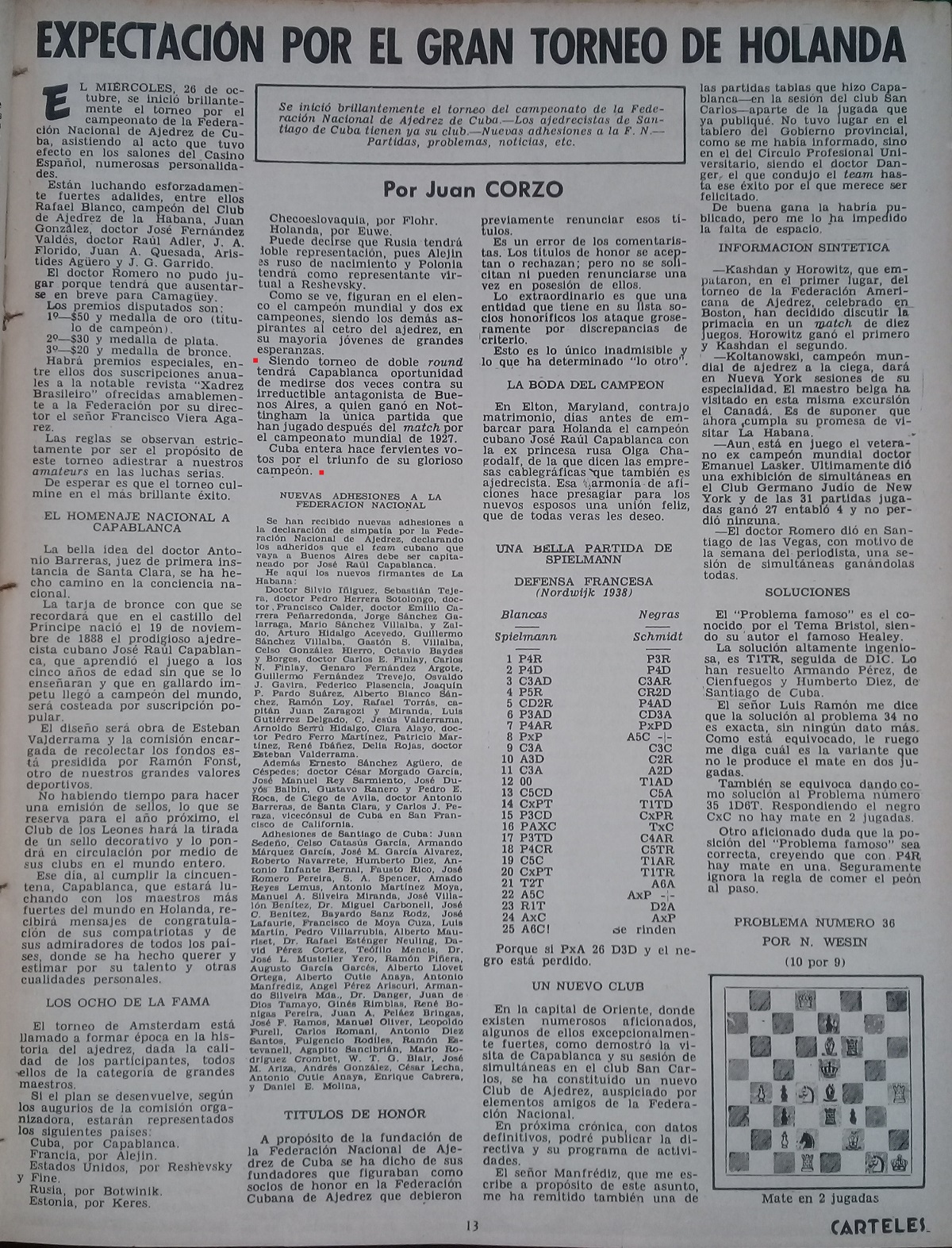
6 November 1938, page 13
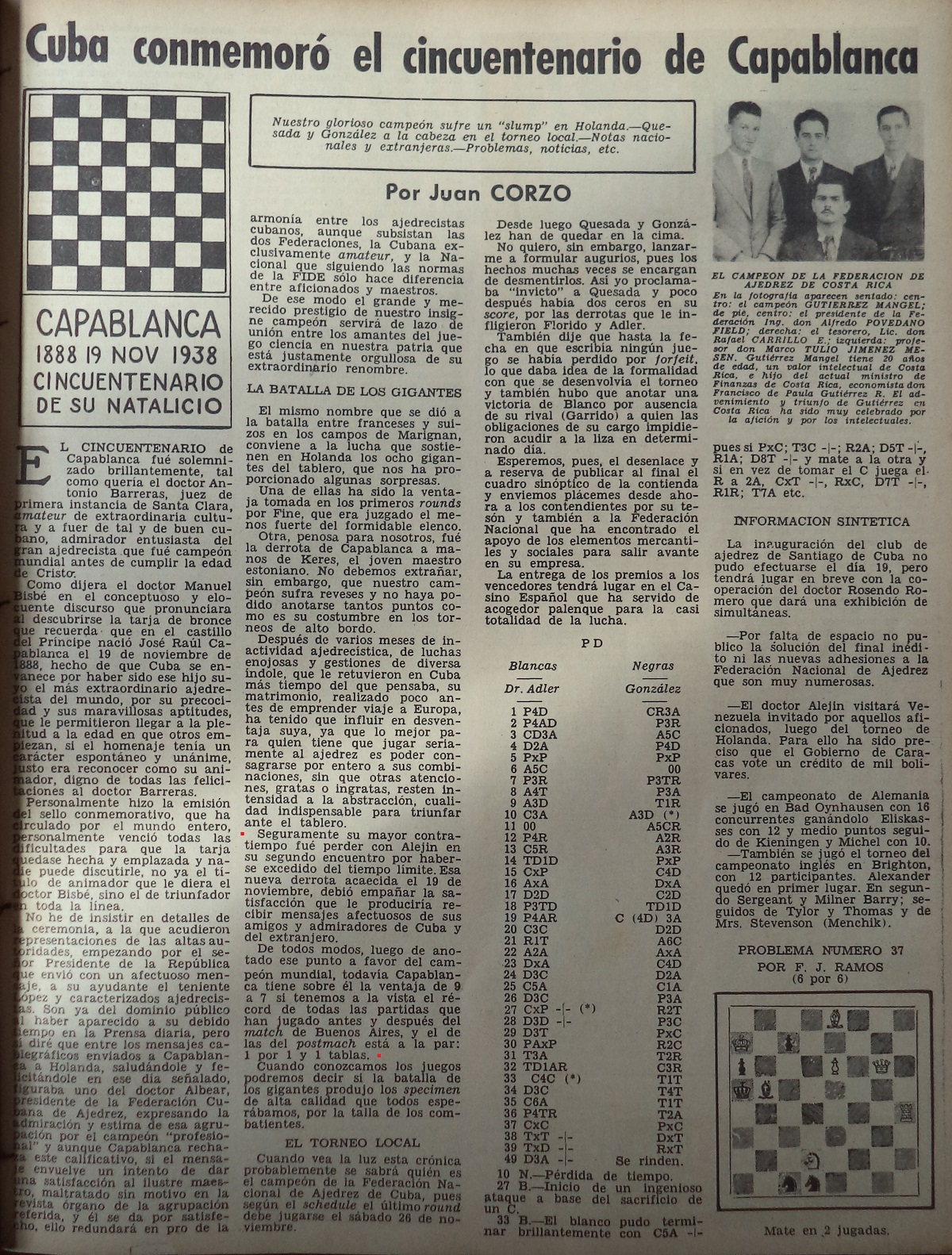
4 December 1938, page 13
Yandy Rojas Barrios notes a photograph of Janowsky in play against Juan Corzo (Havana, 1913) in Capablanca-Magazine, 28 February 1913, page 45:
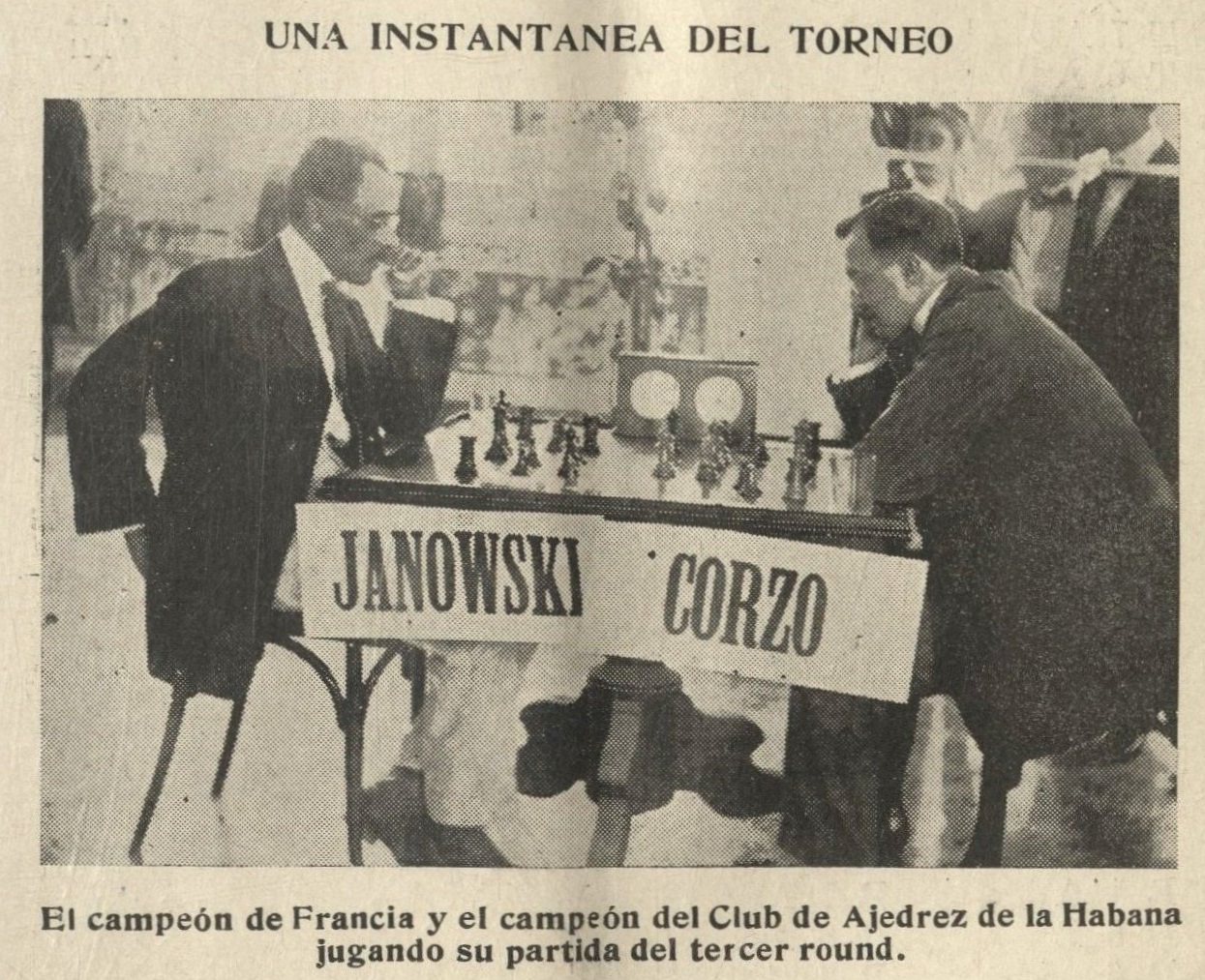
The original in the Cuban periodical is difficult to reproduce well, but the above good scan has been provided by the Cleveland Public Library.
(11867)
From Yandy Rojas Barrios:
‘After his match against F.J. Marshall in the United States, Capablanca resided in Havana from July to September 1909. During his stay, he played five games against Juan Corzo, one against Rafael Blanco and one against René Portela. He also played his first blindfold game against three opponents in consultation and gave one simultaneous exhibition (+23 –1 =1).
Concerning the five games against Corzo, Game 1, played on 21 July, was drawn. It was published on page 5 of the evening edition of the Diario de la Marina, 22 July 1909 and was included on pages 37-38 of The Unknown Capablanca by David Hooper and Dale Brandreth (London, 1975).
On 23 July, Games 2, 3 and 4 were played.
Game 2, won by Capablanca, appeared on page 3 of La Discusión, 24 July 1909, as cited on page 20 of your book on Capablanca. You refer to it as the first of the games played on 23 July, which is correct.
Game 3 was published in neither the Diario de la Marina nor La Discusión. Corzo merely made the following comment on page 5 of the evening edition of the Diario de la Marina, 24 July 1909: “Demoralized by the unexpected disaster [in Game 2], I did not put up much resistance in two successive games, in one of which, trying to avoid the formidable Queen’s Gambit, I faced an arduous defensive task ...”:
The game-score can be found in volume one of Secrets of the Russian Chess Masters by L. Alburt and L. Parr (New York, 1997). See, in particular, pages 101-102. (Acknowledgement: the Cleveland Public Library.) The book dated the game 23 July, but no other information was supplied, about either the occasion or about how the moves were obtained. Further details will be welcome. It is the only game in the series in which Capablanca was White: 1 d4 d6 2 Nc3 Nd7 3 d5 e5 4 dxe6 fxe6 5 Nf3 Ndf6 6 e4 e5 7 Bc4 Bg4 8 h3 Bh5 9 g4 Bf7 10 Bxf7+ Kxf7 11 Ng5+ Ke8 12 Be3 c6 13 Qd3 Ne7 14 O-O-O Ng6 15 Ne6 Qd7 16 Nxf8 Rxf8 17 Qxd6 Qxd6 18 Rxd6 Ke7 19 Rhd1 Kf7 20 g5 Nh5 21 Rd7+ Kg8 22 Rxb7 Rf3 23 Rxa7 Raf8 24 a4 Rxh3 25 a5 Ngf4 and Black resigned.
I am pleased to report that I have found Game 4, played on 23 July, on page 5 of the evening edition of the Diario de la Marina, 24 July 1909:
1 e4 e5 2 Nf3 Nc6 3 Bb5 a6 4 Ba4 Nf6 5 O-O Be7 6 Re1 b5 7 Bb3 d6 8 d4 Nxd4 9 Nxd4 exd4 10 Bd5 Nxd5 11 exd5 O-O 12 Qxd4 Bf6 13 Qd3 Re8 14 Rd1 Qe7 15 Nd2 Bg4 16 f3 Bf5 17 Ne4 Bxe4 18 fxe4 Qxe4 19 Qxe4 Rxe4 20 c3 Rae8 21 Bd2 Re2 22 Re1 Kf8 23 Rxe2 Rxe2 24 Rd1 Bh4 25 Kf1 Re5 26 g3 Be7 27 Be1 g5 28 Bf2 g4
29 a4 bxa4 30 Rd4 h5 31 Rxa4 Rxd5 32 Rxa6 Rd1+ 33 Be1 Bg5 34 Ra8+ Ke7 35 Ra5 f6 (From this point the score in the Cuban newspaper is evidently wrong. There follows here a proposed reconstruction.) 36 b4 Ke6 37 Ra2 Rb1 38 h3 gxh3 39 Rh2 Rc1 40 Re2 + Kf5 41 Kg1 Kg4 42 Kh2 f5 43 White resigns.
Game 5, played on 31 July, was drawn. It was published on page 5 of the evening edition of the Diario de la Marina, 2 August 1909 and is on pages 38-39 of The Unknown Capablanca. Hooper and Brandreth referred to it as “the second game” because they were aware of only two games; The Unknown Capablanca even speculated that they were two thematic games, given that they had the same opening.
Capablanca’s games against Blanco and Portela, played on 25 and 27 July respectively, are on page 20 of your book, from La Discusión. You note that the newspaper garbled the final moves of the Blanco game, and I think that the likely finish was 29 Qxe1 Qxg4 30 Qxe4 Qf3+ 31 Qxf3 Nxf3 32 White resigns.
The blindfold game played by Capablanca on 22 August against Corzo, Blanco and Rensolí, which you also gave on page 20 of your book from La Discusión, was published too on page 5 of the evening edition of the Diario de la Marina, 22 August 1909.
As regards the simultaneous display by Capablanca on 14 September, some details are available: “The session began at nine o’clock [at night] and lasted approximately 2½ hours. The result was one lost game by the inadvertent touching of a piece; another game was drawn and the rest were won by the Cuban champion” (Diario de la Marina, morning edition, 15 September 1909, page 9).
Capablanca’s lost game was not published in the Diario de la Marina or in La Discusión. The only draw, against José Antonio Jover, was given on page 5 of the evening edition of the Diario de la Marina, 15 September 1909. Capablanca was White: 1 e4 e5 2 Nf3 Nc6 3 Bb5 d6 4 O-O Bd7 5 Re1 a6 6 Ba4 b5 7 Bb3 f5 8 exf5 Bxf5 9 d4 Nf6 10 dxe5 dxe5 11 Qxd8+ Rxd8 12 Ng5 Rd7 13 c3 Na5 14 Bd1 h6 15 Nf3 Bd6 16 Nxe5 Re7 17 Nf3 Rxe1+ 18 Nxe1 O-O 19 a4 b4 20 Bd2 c5 21 cxb4 cxb4 22 Bc2 Bxc2 23 Nxc2 Rc8 24 Ne1 Nb3 25 Ra2 Nc1 26 Ra1 Nb3 Drawn.
I have found that Capablanca’s victory over Juan Corzo in that 14 September simultaneous display was published on page 9 of the morning edition of the Diario de la Marina, 18 September 1909:
1 d4 d5 2 Nc3 e6 3 e4 dxe4 4 Nxe4 Nd7 5 Nf3 Ngf6 6 Bd3 Nxe4 7 Bxe4 Nf6 8 Bd3 Be7 9 c3 Nd7 10 O-O Bf6 11 Re1 Nb6 12 Bf4 h6 13 Be4 c6 14 a4 g5 15 Be5 g4 16 Bxf6 Qxf6 17 Ne5 h5 18 a5 Nd7 19 a6 Nxe5 20 dxe5 Qe7 21 axb7 Bxb7 22 Qd4 c5 23 Qa4+ Kf8 24 Rad1 Bxe4 25 Rxe4 Rd8 26 Rxd8+ Qxd8 27 g3 Qd2 28 Kg2 Qd5
29 Qc4 Ke7 30 Qxd5 exd5 31 Ra4 c4 32 Rxa7+ Ke6 33 Rb7 Kxe5 34 Rxf7 Rb8 35 Re7+ Kf5 36 Re2 d4 37 cxd4 Rd8 38 Re5+ Kf6 39 Rxh5 Rxd4 40 Rb5 Ke6 41 h4 gxh3+ 42 Kxh3 “and after a few moves Black resigned”.’
(11878)
From page 106 of the May 1912 American Chess Bulletin:
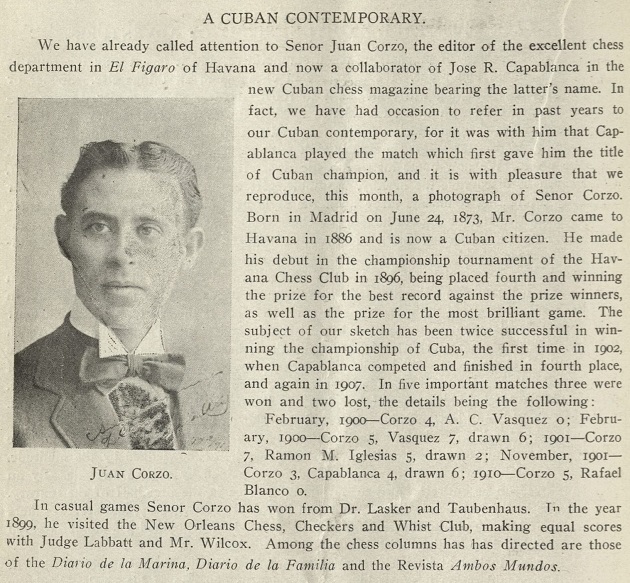
The photograph is not in our feature article on Juan Corzo because it is a case of mistaken identity, as was pointed out on page 136 of the June 1912 edition of the Bulletin:
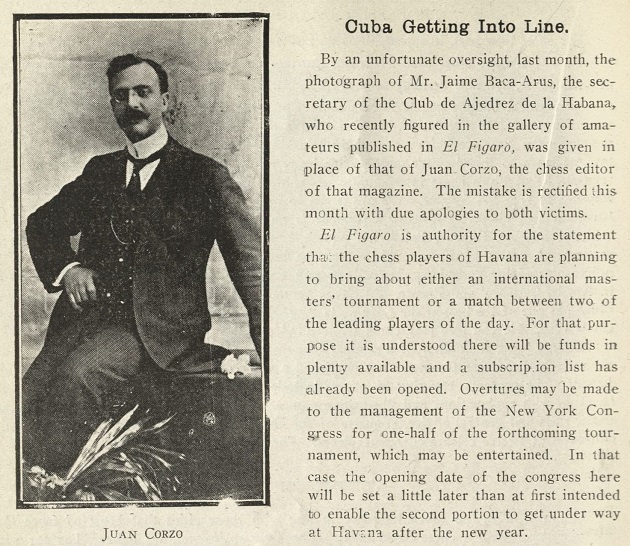
The above scans have been provided by the Cleveland Public Library.
Olimpiu G. Urcan (Singapore) has restored the Jaime Baca-Arús photograph:
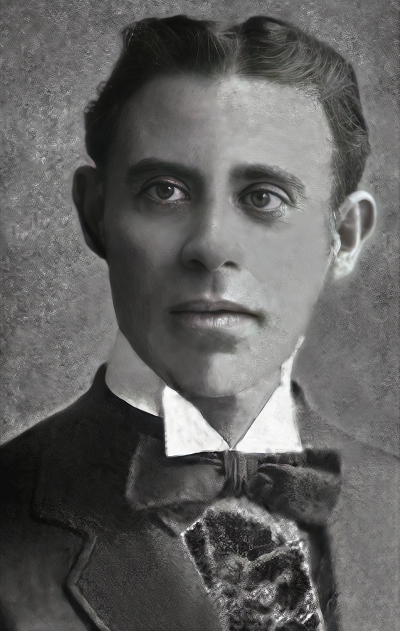
(11881)
To the Chess Notes main page.
To the Archives for other feature articles.
Copyright: Edward Winter. All rights reserved.